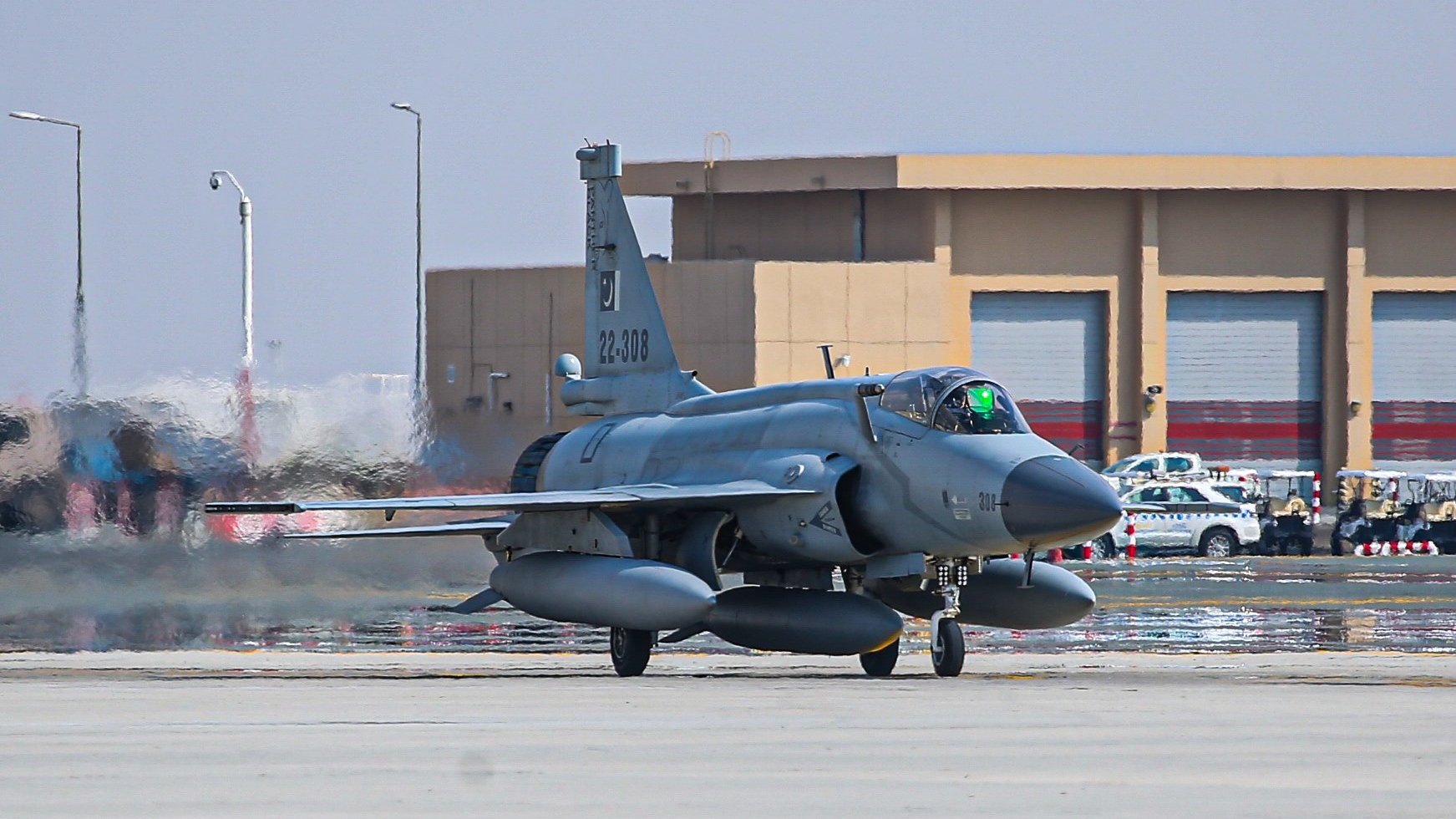The Islamic Republic of Pakistan carried out retaliatory air strikes against its neighboring Islamic Republic of Iran using Chinese-built fighter jets JF-17 ‘Thunder’ and J-10C’ Vigorous Dragon’ early Thursday.
Pakistan also deployed Chinese Unmanned Aerial Vehicle Wing Loong II in its operation named ‘Marg Bar Sarmachar’, which loosely translates to “death to the guerrilla fighters”.
Multiple reports indicated that the Pakistan Air Force launched retaliatory airstrikes against Iran, targeting militant positions further upping the ante against Tehran. The strikes in Sistan and Baluchistan on Thursday were preceded by Iran’s attack Tuesday on Pakistani soil using ballistic missiles.
The two countries share a 900 km long porous border.
The attack was carried out at the break of dawn. According to OSINT reports, shortly before 0600 hours on Thursday, Pakistan’s’ strike package, comprising JF-17 Thunder fighter jets from the Number 2 ‘Minhasians’ Multirole Squadron from the Pakistan Air Force (PAF) Masroor (Karachi) air base, carried out “lethal counter-insurgency specific precision air strikes inside Iran”.
The PAF fighter jets carried out the “pre-emptive” strikes “using stand-off extended range munitions while they remained inside Pakistani airspace.”
Seven locations were targeted after aerial reconnaissance carried out by UAVs confirmed the “presence of high-value terrorist targets.” Medium-altitude long-endurance and strike-capable Wing Loong UAVs were also deployed during the strikes.
The PAF’s fighters engaged the targets inside Iran with precision-guided air-to-ground munitions, where the Balochistan-centric terrorist organization BLF is alleged to be operating. “These targets were over 80 kilometers inside Iranian territory. Seven people are reported to have been killed in the strikes.
The primary precision-guided munition (PGM) used by Pakistan in the airstrikes was the GIDS B-REK (Boosted Range Extension Kit), a rocket-boosted glide bomb precision-guided weapon with a range of 170 kilometers.
In March 2017, Pakistan integrated the JF-17 with the range extension kit, a stand-off range air-to-surface weapon produced by Global Industrial and Defense Solutions (GIDS).
It is similar to US JDAM-ER. The REK converts the MK-80 series general-purpose bombs into GPS/INS-guided bombs with a range of 50-60 kilometers and an accuracy of less than 20 meters CEP.
Additionally, Pakistani J-10C fighters provided air cover and electronic warfare support.
JF-17 Backbone Of PAF
With at least 125 aircraft in service, the JF-17 serves as the PAF’s backbone. They were purportedly used to carry out airstrikes against terrorists in northern Pakistan and, according to one account, to shoot down an Iranian-made drone in southern Pakistan in 2017.
JF-17 Thunder is a single-engine, lightweight, multi-role combat aircraft jointly developed by China and Pakistan. PAC Kamra has delivered nearly 120 JF-17 Block I and II fighter jets to the PAF since 2009.
Since its induction in the PAF in 2007, the JF-17 has been upgraded several times. The JF-17, with a service ceiling of 50,000 feet and a peak speed of around 1,200 mph, can carry out a variety of tasks, including aerial intercept and ground assault. It can hold around 7,000 pounds of ordnance on seven hardpoints and is equipped with a single twin-barrel 23 mm autocannon.

The JF-17 is only in service with three countries — Pakistan, Myanmar, and Nigeria. In December 2023, PAF inducted the latest Block III variant into its fleet.
J-10C – The Dragon from the East
J-10C is one of the latest acquisitions in PAF’s fleet. The aircraft was inducted in March 2022 to counterbalance India’s procurement of French-built Rafale fighter jets.
Pakistan has been calling the Chinese jet the “Dragon from the East.” The omni-role aircraft is armed with an advanced electronics warfare suite.
Pakistan is the second country in the world to operate the J-10, with China being the other country whose People’s Liberation Army Air Force (PLAAF) and People’s Liberation Army Navy (PLAN) operate the aircraft.
The J-10C’ Vigorous Dragon’ is a medium-weight, all-weather fighter aircraft and can be equipped with a variety of 4th-generation air-to-air missiles, including the Chinese PL-10 short-range missile and the PL-15 beyond visual range missile.
The J-10C is far more sophisticated in terms of aerodynamics and avionics than the JF-17, and it is a much larger aircraft with a higher payload. It is also more competent in practically all performance domains.
The J-10C in Chinese service has notable features like an infrared search and track and laser rangefinder dome in front of the cockpit, as well as a glass cockpit with a wide-angle holographic head-up display. It is also equipped with an Active Electronically-Scanned Array (AESA) radar.
Pakistan’s Foreign Ministry Speaks
Pakistan’s Foreign Affairs Ministry, in a statement, said: “This morning Pakistan undertook a series of highly coordinated and specifically targeted precision military strikes against terrorist hideouts in Siestan-o-Baluchistan province of Iran. Several terrorists were killed during the Intelligence-based operation – codenamed ‘Marg Bar Sarmachar.'”
The statement added: “Over the last several years, in our engagements with Iran, Pakistan has consistently shared its serious concerns about the safe havens and sanctuaries enjoyed by Pakistani origin terrorists calling themselves ‘Sarmachars’ on the ungoverned spaces inside Iran. Pakistan also shared multiple dossiers with concrete evidence of the presence and activities of these terrorists.”
The two nuclear-armed Islamic countries have long blamed each other with suspicion over militant attacks. Several militant groups operate in Iran and Pakistan, including the Jaish al-Adl Sunni separatist group, which Tehran struck with its strike. They all share the goal of establishing an independent Baluchistan for ethnic Baluch communities in Afghanistan, Iran, and Pakistan.
For more than 20 years, Baluch nationalists have waged a low-level insurgency in Pakistan’s Baluchistan region and Iran’s neighboring Sistan and Baluchestan province.
A deputy governor of Iran’s Sistan and Baluchestan province, Ali Reza Marhamati, in a telephone interview with the Associated Press, confirmed Thursday’s strike, saying the dead included three women and four children. He did not immediately elaborate other than to say that the dead were not Iranian citizens.
- Ritu Sharma has been a journalist for over a decade, writing on defense, foreign affairs, and nuclear technology.
- She can be reached at ritu.sharma (at) mail.com
- Follow EurAsian Times on Google News